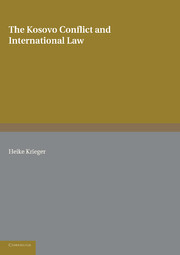Book contents
- Frontmatter
- Contents
- Map
- Preface
- Chronology
- Introduction
- Chapter 1 Kosovo's Status in Yugoslavia before 1999
- Chapter 2 Development of the Human Rights Situation pages 14 to 40
- Chapter 2 Development of the Human Rights Situation pages 41 to 64
- Chapter 2 Development of the Human Rights Situation pages 65 to 90
- Chapter 2 Development of the Human Rights Situation pages 90 to 114
- Chapter 3 Diplomatic Efforts for the Settlement of the Crisis pages 115 to 146
- Chapter 3 Diplomatic Efforts for the Settlement of the Crisis pages 147 to 187
- Chapter 3 Diplomatic Efforts for the Settlement of the Crisis pages 187 to 217
- Chapter 3 Diplomatic Efforts for the Settlement of the Crisis pages 218 to 253
- Chapter 3 Diplomatic Efforts for the Settlement of the Crisis pages 253 to 286
- Chapter 4 Military Action against Yugoslavia pages 287 to 313
- Chapter 4 Military Action against Yugoslavia pages 314 to 352
- Chapter 5 Settlement of the Crisis
- Chapter 6 Statement by NATO Memeber States
- Chapter 7 International Reactions to the Crisis pages 424 to 460
- Chapter 7 International Reactions to the Crisis pages 461 to 499
- Chapter 8 Court Action with regard to the Kosovo Crisis
- Chapter 9 Implementation of the Principles for a Political Solution of the Conflict
- Chronological List of Documents
- Select Bibliography
- Index
Chapter 9 - Implementation of the Principles for a Political Solution of the Conflict
Published online by Cambridge University Press: 05 July 2014
- Frontmatter
- Contents
- Map
- Preface
- Chronology
- Introduction
- Chapter 1 Kosovo's Status in Yugoslavia before 1999
- Chapter 2 Development of the Human Rights Situation pages 14 to 40
- Chapter 2 Development of the Human Rights Situation pages 41 to 64
- Chapter 2 Development of the Human Rights Situation pages 65 to 90
- Chapter 2 Development of the Human Rights Situation pages 90 to 114
- Chapter 3 Diplomatic Efforts for the Settlement of the Crisis pages 115 to 146
- Chapter 3 Diplomatic Efforts for the Settlement of the Crisis pages 147 to 187
- Chapter 3 Diplomatic Efforts for the Settlement of the Crisis pages 187 to 217
- Chapter 3 Diplomatic Efforts for the Settlement of the Crisis pages 218 to 253
- Chapter 3 Diplomatic Efforts for the Settlement of the Crisis pages 253 to 286
- Chapter 4 Military Action against Yugoslavia pages 287 to 313
- Chapter 4 Military Action against Yugoslavia pages 314 to 352
- Chapter 5 Settlement of the Crisis
- Chapter 6 Statement by NATO Memeber States
- Chapter 7 International Reactions to the Crisis pages 424 to 460
- Chapter 7 International Reactions to the Crisis pages 461 to 499
- Chapter 8 Court Action with regard to the Kosovo Crisis
- Chapter 9 Implementation of the Principles for a Political Solution of the Conflict
- Chronological List of Documents
- Select Bibliography
- Index
Summary
By resolution 1244 (1999) (document no. 208; see Chapter 5) the UN Security Council authorised member States and relevant international organisations to set up an international security presence - KFOR - and decided that its responsibilities would include preventing renewed hostilities, demilitarising the KLA, and establishing a safe environment for the return of the refugees as well as for the operation of an international civil presence. The deployment of KFOR was synchronised with the departure of the Serbian security forces. By 20 June 1999, the Serb withdrawal was complete and KFOR established in Kosovo. On the same day, NATO Secretary General Solana announced that, in accordance with the Military Technical Agreement (document no. 207), he had formally terminated the air campaign (document no. 328). Neither Resolution 1244 (1998) nor its annexes regulated the Russian participation in KFOR. During further talks the Russian government refused to place its troops under the command of NATO but suggested to create a separate Russian sector. The Russian Federation intended to deny freedom of operation to the NATO forces throughout its sector. On 11 June 1999 before the arrival of NATO forces, Russian forces occupied the Pristina airfield, the incident increased the tensions between the NATO states and the Russian Federation. The Agreement on Russian Participation in KFOR concluded in Helsinki on 18 June 1999 resolved the dispute about the airfield and regulated, inter alia, the maximal Russian deployment (document no. 326). However, the agreement did not grant a separate sector to the Russian forces.
- Type
- Chapter
- Information
- The Kosovo Conflict and International LawAn Analytical Documentation 1974–1999, pp. 531 - 583Publisher: Cambridge University PressPrint publication year: 2001

